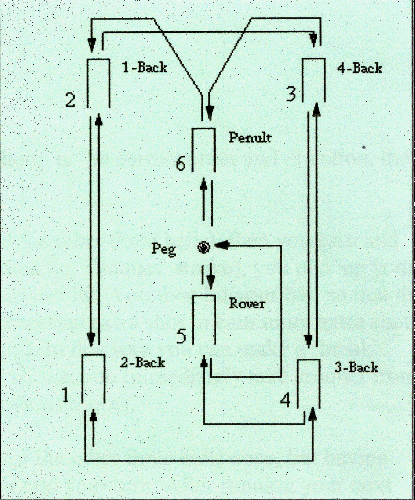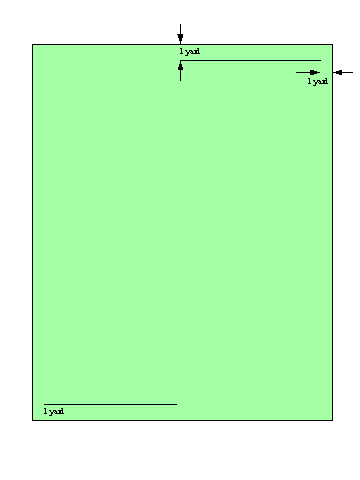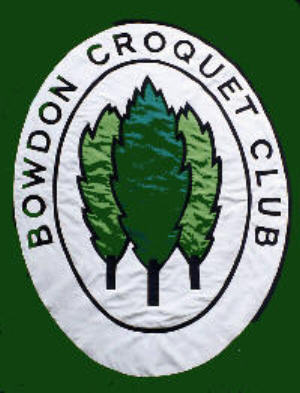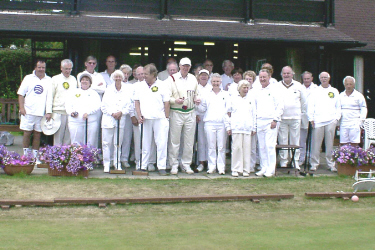FREQUENTLY
ASKED QUESTIONS
|
1.
|
How many hoops have to be gone through in
the course of a game?
-
Both balls of a side have to be played
through 12 hoops in a precise order and direction and each ball must
then be made to hit the centre peg. One point is scored for each hoop
and for the peg, a total of 26 points for the two balls. The side which
first scores 26
points wins. However, in timed games, the player with the most number
of
hoops wins.
|
2.
|
In what order do the hoops have to be
played?
- The first hoop is the one with its top painted
blue. The order and direction of the twelve hoops is shown in the
diagram on
the right. To score a point a hoop must be played in this sequence and
from the direction shown: you cannot skip a hoop and come back to it
later.
|

|
3.
|
Does a player have to put both balls
through
the first hoop before he can go on to play through the second?
- No. At the start of every turn the player (or
the side in the case of doubles) can choose which ball to play
with. He will normally elect to play with the ball which
is most favourably placed. It is quite normal for one
ball of a side to go through many hoops before the other
ball has even made the first hoop.
|
4.
|
What are the clips on the hoops for?
- As it would be difficult to remember which
of the 12 hoops each ball has already run, coloured clips are
used to show how far round the course each ball has gone.
A clip on the top of the hoop means that the
ball is still on the first circuit; a clip on the
upright of the hoop means that the ball has been through the
first six hoops and is now on the second circuit.
When a ball has made all twelve hoops the clip is placed
on the centre peg, and when the ball has hit the
centre peg the clip and ball are removed from the lawn. By
looking at the position of the clips anyone can
work out how many hoops each side has made and, thus, who
is in the lead.
|
5.
|
How is the game started?
- At the start of the game the clips are
placed on the blue
painted top of the first hoop. Players then take alternate
turns to play their four balls on to the lawn. A ball may
start from any position on either of the start (or baulk)
lines, which are shown in the diagram on the right. The
first four turns must be used to play the four balls
on to
the lawn. The balls do NOT have to be played in any
particular order of colours; the sides simply toss
for
start and the starting side can play either of its
two
balls first.
|

|
|
Opening tactics are
usually concerned with leaving the balls in a safe position. Most
beginners are puzzled
why players do not try for the first hoop. With only
about ⅛th inch
clearance it is very unlikely that a
shot from the baulk line would go through the first
hoop. The minimum distance is 6 yards away – and
accuracy of ⅛th inch in 18
feet is impossible except by a fluke. The most likely result of trying
to go
through the first hoop would be to hit the hoop.
This would leave your ball very near to the hoop. Now
to hit a ball which is 3⅝th inch in diameter from 6
yards away is a different proposition and your
opponent would have a good chance of hitting in and
scoring.
N.B. There is a widespread belief among garden-croquet players that you
cannot hit another ball until you have been through the first hoop.
There is no such restriction in Association Croquet.
|
6.
|
What is a Break?
- The term is
used, as in snooker, to describe a turn in which the player has the
balls in
a favourable
position to score and from which he should be able
to play a series of scoring shots. As in snooker, he
may lose the break through making a poor shot or he
may give up the break because of the need to play
a safety shot.
N.B. It
is, perhaps, worthy of mention that the maximum number of strokes that
can
be made in a snooker break is 38, which clears the table. In
Association Croquet a break of 60 or more shots is quite common – the
maximum number of strokes in a break is 91.
|
7.
|
What entitles a player to play so many
strokes
- A
turn consists of one stroke – but extra strokes can be earned in one of
two
ways:
a). when a player runs his ball through a hoop he
becomes entitled to play another stroke;
b). when a player hits another ball with his, he
becomes entitled to two more strokes: the first of these is called ‘the
croquet stroke’ and the second is called ‘the continuation stroke’.
In order to play the ‘croquet stroke’
the player must pick up his ball (from whatever point it stopped
rolling) and place it in contact with the other ball wherever that ball
ahs stopped moving. If the other ball has been driven off the lawn it
is brought back on to the lawn exactly one yard in from the boundary
line and the player’s ball is placed in contact with it.
So the croquet stroke is always played
with the two balls touching. The player can only hit his own ball with
the mallet (it is a fault if he allows his mallet to hit the other ball
and his turn ends) but because the two balls are in contact the act of
striking his
own ball naturally causes the other ball to move as well as his own.
N.B. In the very old days in garden
croquet, it was permitted to put your foot on your ball and to hit it
hard so that the ball with which it was in contact was sent into the
shrubbery – this is NOT part of the game of Association Croquet.
A player is allowed to hit and thus take
croquet from EACH of the other three balls (friend and foe alike) on
the lawn
in any turn to help him go through a hoop ….. and each time his ball
runs
through a hoop he can repeat this process. Perhaps now you can begin to
appreciate how, by clever use of these strokes, a player can manoeuvre
his ball around the lawn and take many hoops in a break.
The croquet stroke is one of the great
manoeuvring strokes in the game. One of the uses of this stroke is, for
instance,
to move your ball so that it stops in front of its hoop – you can then
use the ‘continuation stroke’ as mentioned in a) above. You can use
this
other stroke to hit any other ball on the lawn and thus become entitled
to TWO more strokes which, in turn, you can use to go through a hoop
thus
becoming entitled to another stroke and so you can go on making hoop
after
hoop.
But,
of course, you are not always able to croquet your ball in front of its
hoop – for instance, you may be having to take croquet from a ball
which is on the other side of the lawn and far away from your next hoop
– you could
not be sure of playing the croquet stroke so as to put your ball so
accurately in front of its hoop as to be able to go through it in the
continuation stroke. In these circumstances you could use the croquet
stroke to move your ball near to a third ball which is much closer to
your hoop and then use the continuation shot
to hit that ball, which of course entitles you to two more
strokes. Now, because you are much nearer to your hoop you have a
better chance
of being able to get accurately in front of the hoop in the croquet
stroke so that it can be run through in the continuation stroke. Think
of it as using a series of stepping stones to reach your
destination!
|
8.
|
What happens when a ball crosses the
boundary line?
-
Except for the player’s own ball, any ball touching or crossing the
boundary
line or stopping within the
yard of the boundary line within the lawn, must be placed
immediately and before the next stroke is take,
exactly one yard within the lawn. This line one yard
within the boundary line is not marked and you will
need to use your mallet as a yardstick to measure the
exact spot on which the ball is to be replaced.
A player’s own ball is also placed on the
yard line if it touches or crosses the boundary line without hitting
another ball, or if it goes off in the croquet stroke. If
a player’s own ball crosses the boundary line after
hitting another ball that it is entitled to hit then, of
course, it is simply moved into position to take croquet;
the fact that it has crossed the boundary line is
immaterial.
|
9.
|
How does a turn end?
- There are a
number of ways in which a turn comes to an end.
Involuntarily
a). If a player
fails in his attempt to hit another ball or to go through a hoop.
b).
If, in the croquet stroke, he sends
either his ball or the croqueted ball over the boundary line. However,
there is one exception to this rule and that is when (before crossing
the boundary line) his own ball roquets another ball.
N.B. It
is only in the croquet stroke that the turn ends when either ball
crosses the line; in an ordinary hit both balls may be sent off without
penalty.
c).
There are also numerous faults that a
player can make during the act of striking his ball, any one of which
brings his turn to an end. This is not the place to list these and they
are quite numerous and technical – these are all detailed in the Laws
of the Game, a copy of which can be obtained from the Croquet
Association. It is something that is always useful to have handy in
case of dispute in a game you may be playing when there is no one else
around to ask; however, a copy is
usually hanging up in the clubhouse near the notice board. Normally if
a player is about to play a stroke in which he may commit a fault he
will
call for a referee to watch the stroke and adjudicate. He calls for a
referee
by raising his mallet in the air.
N.B.
You will observe that a referee will use
plastic markers to mark the positions of the
balls; this is simply because the balls have to be replaced in the
event of the stroke being a fault. Coins should NEVER be used on the
lawn in case they are inadvertently left and remain there when the
lawns are next mowed, causing insurmountable damage to very expensive
club lawnmowers.
Voluntarily
d). A player can, of course, voluntarily decide
to end his turn at any time. If he finds himself in such a
position that he
has gone as far as he wants to go with that ball or the only possible
shots are difficult
and if unsuccessful would leave
the balls very favourably placed for his opponent, he will often
choose to play safe by
finishing his turn in such a way as to make it as difficult as possible
for his
opponent to be able to
start a break.
|
10.
|
What do you mean by ‘wiring an opponent’?
- One
interesting
and skilful tactical weapon is to interpose a hoop or the peg between
two
balls so that a
direct shot from one ball is not able to hit either side
of the other ball. This is called ‘wiring’ and, of
course, has some resemblance to the art of snookering. It
is, however, always disconcerting to find that
your opponent has left your two balls wired from each
other either side of HIS next hoop. Whichever
ball you elect to play, you are bound to leave the other
near to his hoop. His own two balls will have
been left in the furthest corner conveniently near to one
another. Your only course is to try a long shot at
him if you do not want him to benefit from this position.
|
11.
|
Is there any limit to the number of
hoops
a player can make in one turn?
- No, a player
can, if he wishes, make all twelve hoops but this is usually only done
when
the second ball
has previously made its twelve hoops, in which case
it can be pegged out thus leaving himself with one
ball. However, a player who is left with only one
ball on the lawn and a number of hoops to make is
seriously disadvantaged for he must hit one of
his opponents balls in order to get a break going and this
is very difficult against an opponent who can skilfully
hide behind hoops and make it impossible or, at
best, very difficult.
The most likely course in a first class
game is for the first ball to be taken through the first nine hoops
after
which the player will lay-up in such a way as to
give the opponent a long shot only.
|
12.
|
What is a ‘lift’ shot?
-
Very good players are able to go round
the lawn and run all 12 hoops in one turn, should they so desire. Such
people prefer to play to advanced level rules in order to give the
opponent a
chance otherwise the game would be over very quickly should a player
then
take his second ball right the way round and peg out both balls in his
next
turn.
In Advanced Level Play, if a player goes through either of the 7th
(1-back) or the 10th hoop (4-back) it gives the opponent the
choice of starting his next turn with a ‘lift’. A ‘lift’ allows the
player to pick up either of his two balls and to play it from any
position he
chooses on either baulk line. This makes it more difficult to lay up
safely
at the end of a turn – but it does at least give the opponent a chance
of hitting in and starting a break.
There is another rule in Advanced Level Play such that when a ball goes
through the 10th hoop in the same turn as it goes through
the 7th hoop this automatically gives his opponent the
considerable advantage
of being allowed to start his next turn by picking up either of his
balls
and putting it in contact with any other ball on the lawn. In effect,
starting his turn with a croquet stroke. This is tantamount to handing
the initiative over to your opponent. So serious is this disadvantage
that very, very
rarely will a player accord it to his opponent by running the 7th
and 10th hoops with his first ball in the one break.
The existence of the rules which give a
‘lift’ or ‘contact’ has created the skill of peeling.
-
Whenever a player enters the lawn and
finds himself ‘wired’ from all the other balls (see Question 10. above)
as a result of his opponent being responsible for the position of the
balls, then that player is entitled to a ‘lift’ and may play it from
any position he chooses on either baulk line, should he so desire (as
per above).
|
13.
|
What is ‘peeling’?
- As you are
aware, it is a perfectly legitimate exercise to use the ball with which
you are playing to hit
another ball (friend or foe) through its hoop.
This is usually done in the croquet stroke, although a ball
can also be peeled through its hoop by being
roqueted through. When a ball is ‘peeled it scores its point
for that hoop and the clip is moved on to the next
hoop.
A very attractive and highly skilled
manoeuvre is often attempted in the first class game – this is the
process of peeling your partner ball through its last three (or more)
hoops whilst you are taking your second ball around the course. The
‘perfect’game is one in
which a player makes nine hoops with his first ball and then lays up;
his
opponent hits in, makes nine hoops and then lays up himself; the first
player hits in, makes all 12 hoops and the peg whilst peeling his
partner
ball through its last 3 hoops causing it to hit the peg, thus winning
in
two turns.
-
Of course, you can also peel your
opponent through his hoops and some exciting games result from peeling
your opponent’s ball through its last 3 hoops and pegging it out, thus
leaving him with only one ball – which, as has already been said, is a
disadvantage to him.
|
14.
|
Do
players ‘concede’ when they are far behind, as in snooker?
-
This
does not happen. Association Croquet is a remarkable game in that no
game
is lost until your
opponent has made 26 points so that there is no such
thing as a hopeless position. Some of the most
exciting games arise when a player who has not yet scored
suddenly gains the initiative from an
opponent who ahs made 24 or 25 points. Many games have
been won from this position.
|
|
|



